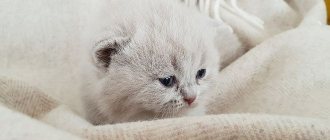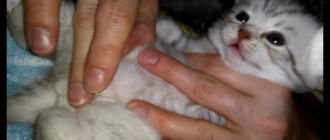How to care for a kitten at home
The formation of the body, health and life expectancy of an adult cat depend on proper care in the early period of life.
The formation of the body depends on proper care in the early period of life
Caring for newborn kittens
If the babies are with a cat, then the mother takes care of the offspring and the owner has few worries.
Need to control:
- "Nest" state. Clean the litter from wool and dirt.
- Weight gain. Newborns weigh approximately 120 g and, with normal development, gain 100 g weekly. Kittens grow a little faster than female cats. If the baby is growing more slowly, then he needs to be shown to the veterinarian.
- Condition of fur, eyes and ears. The coat should be dry and clean, and there should be no discharge from the ears and eyes. The cat's mother licks her offspring and healthy babies are always clean.
On the 8th day, the eyes open, by the end of the second week the babies begin to hear, and on the 20-21st day the kitten tries to walk.
There is no need to worry about newborns: the babies eat and sleep, actively gaining weight.
As soon as the baby opens its eyes, stands on its paws and begins to show interest in the world around it , the kitten needs to be picked up and stroked. Positive human contact will help the animal grow up affectionate and playful.
Care at 1 month
At this age, it is better not to take the baby away from its mother.
As soon as the baby opens his eyes, stands on his paws and begins to show interest in the world around him.
But if for some reason a month-old kitten is alone, then it will require special care:
- Feeding. The main diet should be milk. It is better to purchase a cat milk substitute at the veterinary store or dilute the dry milk by adding a little honey or sugar. Complementary foods (meat, porridge) are added in small doses. New food should be given in small quantities so as not to cause intestinal upset. You need to feed 6 times a day.
- Providing peristalsis. The cat licks the baby's tummy, stimulating intestinal function. To help the pet, the owner needs to moisten a cotton pad with warm water and massage first the sides and then the tummy in a circular motion from the sternum to the groin.
- Fresh water. If food is given on a schedule, then water should be in the bowl at all times.
Be sure to read:
How to wash a cat's eyes at home: pharmacy and folk remedies, when required
The animal must be toilet trained immediately. If the kitten begins to worry and “look for a place,” then you need to take it and put it in the tray.
You need to be persistent if the baby tries to run away and refuses to “do his business” in the designated area. The procedure must be carried out several times until the small pet understands where to defecate.
If your pet refuses to go to the litter box, then perhaps he is frightened by the large granules of the filler or does not like the consistency. By changing the toilet filling, you will be able to cope with the problem.
At this age, you should begin to accustom long-haired kittens to brushing. It is better to purchase a soft brush that detangles the fur and does not scratch the skin: then the combing procedure will be perceived as a pleasure by your pet.
Care for 3 months and older
Nutrition. The diet of an adult fluffy during this period is very varied: meat, fish, milk, cottage cheese, egg yolk, cereals, vegetables, cereals (except corn). Food can be offered in bite-sized pieces. But you cannot put the entire daily amount of food into a bowl at once. The pet has not yet learned to clearly control its appetite, so it may eat too much. The norm for one feeding is 200 grams per 1 kg of animal weight. At 3 months, a kitten eats 400 grams of food per day, and at 4 months – 600 grams.
Natural food and wet food should be warm.
Hygiene. Caring for a kitten includes the usual set of hygiene procedures, which is complemented by brushing teeth. By the age of four months, all of the cat’s teeth have erupted, so prevention of dental problems in domestic hermits is mandatory. Teeth are cleaned using small brushes and a paste with a pleasant smell.
global $ads_google; //data-ad-slot=”2475549904″ $ads_google = empty($ads_google) ? false : true; ?> if ($ads_google == false) {?>
$ads_google = true; ?> } ?>
Vaccination. At 3 months the cat is vaccinated a second time. Revaccination includes the same drugs that were used a month ago. The next vaccination is scheduled after a year. After the procedure, you should carefully monitor your pet's well-being. If you notice apathy or restlessness, fever, sneezing, swelling in the injection area or other suspicious symptoms, you should contact a veterinary clinic.
The exciting period for the owner of caring for a kitten passes quickly. But if the pet is surrounded by care and attention, then many problems bypass it. Kotofey grows and develops according to his age and enters adulthood healthy and cheerful.
How to care for kittens without a cat
It is better to purchase a cat's milk substitute.
It happens that the mother dies during childbirth, and the owner is left with blind, squeaking offspring.
The owner will have to replace the kittens' mother:
- Heating. A heating pad with water heated to a temperature of 35°C, on which a soft mattress is laid, works well. It is not recommended to place newborns near heating devices or warm them with an infrared lamp. In the first case, this will cause overheating, and the use of lamps may affect vision when babies open their eyes.
- Feeding. It is better to buy a cat's milk substitute, but if this is not possible, you can use cow's milk, adding a pinch of sugar. It is important not to feed formulas with a high percentage of fat in the first weeks. To give food, use a bottle with a nipple or feed with a pipette. Dishes are washed and sterilized after each meal. Feeding is carried out at intervals of 2-2.5 hours.
- Hygiene. To maintain cleanliness, the baby's fur must be wiped with a damp cloth. Bathing at an early age is prohibited. The ears are cleaned from accumulations of wax with a cotton swab, and to care for opened eyes, it is recommended to take an eye wash from a veterinary pharmacy.
- Stimulates digestion. After each meal, massage your tummy and sides in a circular motion from the chest to the perineum.
Be sure to read:
Which mat cutter is best for cats: straight, curved, how to use it, how much it costs
By the third week, kittens will begin to walk. In addition to feeding and care, you will need to pay attention to education: toilet training, showing a scratching post.
Kittens grow quickly and what is developed in the first days and weeks of life will become the basis for the behavior of an adult animal.
Educational activities
The fluffy little murzik is a beast, although small. He can cause a lot of trouble if you don't educate him. From the first days of his stay in the house, he should be given a clear understanding of what not to do:
- tear up furniture and wallpaper - there is a scratching post for this type of activity;
- break indoor flowers - it is advisable to place them on shelves inaccessible to the animal;
- make puddles on the floor and carpets - if this happens, you need to blot the wet area with a napkin, put it in the cat’s litter box, then bring the cat over, let him sniff and scrape the litter with his paw;
- sleep in a crib with a small child - to increase the attractiveness of his own bed for a pet, the latter can be treated with a spray with a “habituating” smell;
- leaving the fluffy one alone during a “confrontation” with other animals living in the apartment.
Keeping a purr requires maximum patience and tact from the teacher. Under no circumstances should the following pedagogical mistakes be made:
- raising your voice at a tailed prankster - the positive effect of this is zero;
- douse the spoiled one with a spray bottle - as a result of this repellent method, you can purchase a monthly puzzle “how to wash a kitten”; it will be especially difficult to solve it when introducing your pet to water procedures for the first time;
- beat an animal - remember, you are dealing with a vindictive, willful and vindictive creature: it is almost impossible to change it, and turning it against yourself is as easy as shelling pears.
To achieve obedience, the owner of a stubborn little animal has only one proven technique - intonation modulations. He behaved well - he was praised in a warm, gentle voice; guilty - received a calm but severe reprimand. A sensitive and affectionate animal will instantly detect notes of disapproval in the intonation. This will serve as his greatest punishment.
Cats need not only a kind word, but also tactile contact. When communicating with a meowing friend, stroke his fur - this will give him a lot of pleasure. The more time you devote to your baby, the stronger and more trusting your relationship will be.
Don't miss the opportunity to keep your furry little playful girl busy. Research has shown that half an hour of play activity a day is enough to develop not only normal motor skills, but also a friendly character.
Choosing a place for a kitten's toilet
Cats try to satisfy their natural needs in an intimate environment, and the place chosen for the toilet in the apartment must meet a number of requirements:
- Availability. The kitten should be able to go to the litter box at any time.
- Privacy. Animals do not like to be looked at while they are emptying their bowels or bladder.
- Comfort. If the baby does not like the litter, then it is almost impossible to force him to go to the tray. It is recommended to take the pellets that were used by the breeder.
Familiar filler and a comfortable environment will allow the kitten to quickly get used to the new place.
Body hygiene
It is not recommended to wash cats under two months of age, as sudden temperature changes can damage a fragile body. Caring for a kitten for 1 month without a cat involves regular cleaning of the ears, washing the eyes and monitoring the condition of the oral cavity.
Discharge from the eyes and excess wax from the ears should be removed with a sterile cotton swab moistened with boiled water or special drops. If your baby's gums are very red and swollen, take him to a veterinarian for an examination and ask him to prescribe a gel that relieves teething pain.
Animals picked up on the street must be dewormed. It is recommended to do this only after examination at a veterinary clinic and excluding a number of diseases. For the procedure, choose an anthelmintic agent that is appropriate for the pet’s age, preferably in the form of a suspension. We talked earlier about how to properly give medicine to a cat.
Kitten nutrition
How to care for a kitten
It is better to feed the baby on time, with even intervals between meals:
- up to 2 months – 5 times;
- by the age of six months, the frequency of feedings gradually decreases to 3 times, and the portion gradually increases;
- An eight-month-old animal is fed like an adult - twice a day.
Your pet's diet must include:
- raw beef;
- boiled chicken meat;
- milk porridge;
- egg yolk;
- raw and boiled vegetables;
- fermented milk products.
You cannot feed food from the human table: salt and spices are harmful to the cat’s body.
Be sure to read:
Reasons and ways to suppress a cat’s aggression and calm the animal down if it gets angry, meows, cries before bedtime
Veterinarians recommend purchasing balanced cat food for kittens, taking into account age. Specialized mixtures contain all the necessary elements necessary for the growth of a pet.
Find a good veterinarian
If you don't know a veterinarian, ask your friends or acquaintances to recommend someone. If you got your cat from a shelter, ask their advice as they may have veterinarians they have worked with for a long time
One of the first things you should do with your new cat, if not the very first, is take him in for a veterinary examination. This trip is almost as important for the owner as it is for the kitten because it not only checks for health problems such as birth defects, parasites and feline leukemia, but it also allows you to ask all the important questions regarding cat care.
Ask your veterinarian for recommendations on the type of food, how often to feed and portion sizes. Discuss parasite control options that are safe for your kitten, both external and internal. Discuss ways to introduce your kitten to other pets. Schedule future appointments and vaccinations to create a preventive health plan for your kitten.
Toys and other things for development and communication with a kitten
All children love to play, and felines are no exception. Having settled in a new place, the baby begins to enjoy running after a piece of paper on a string or chasing various objects across the floor.
It is better to make sure that the kitten has its own things:
- Movable toys. Fur balls, rubber mice and other similar things. It is important that toys do not have small parts: kittens are teething, the baby can bite off a small part and choke.
- Hanging objects. A ball hanging on a thread on the door handle will occupy the attention of a cat child for a long time.
- Scratching post. Sharpening claws is a natural need of the cat tribe. If you do not acquire this useful item, the furniture or carpet will suffer. In the first days, you need to show your pet a place where it is allowed to sharpen its claws.
A good option would be to purchase a special complex where your pet can climb and jump.
In addition to the fact that the device develops the cat's dexterity and flexibility, purchasing a device will reduce the likelihood that a playful baby will throw flowers from the windowsill or objects from the table.
Teeth
When the kitten has already learned to eat solid food, he needs to brush his teeth every 1-2 days . This can be done with an ordinary cotton swab, carefully removing any remaining food remaining on the teeth and the resulting plaque. If you follow these recommendations, your pet will never have digestive problems.
© shutterstock
Nutritional formula recipe
If you still cannot find a wet nurse, then use the recipe that has been tested by most breeders: mix a glass of 6% milk, a raw egg and a teaspoon of honey. Honey can be replaced with glucose 5%. The resulting mixture is nutritious and well suited for feeding kittens; it should be stored in the refrigerator for no more than a day and heated to the required temperature before each feeding. Pet stores sell powdered milk formulas for kittens, but they are still more suitable for supplementing kittens than for feeding newborns.
Feeding technique
Bottles, pipettes, special cones, disposable syringes, and even syringes are suitable for this purpose. It's important to get used to it. The feeding technique should be as follows: the kitten should be placed on your lap or on the table with its belly down. Under no circumstances should you place your baby face up - he may choke or choke. Gently insert the pacifier into his mouth and hold it at a 45° angle, shaking it slightly to encourage him to suck instinctively. If your kitten coughs, turn him head down so he can catch his breath. While the kitten is suckling, gently stroke its head and back, purr or quietly mumble something to yourself, imitating a cat's peaceful purr. Don't limit your kitten's food intake. When the kitten has eaten and refuses the pacifier, wipe its face and other places soiled with food with a cloth soaked in warm water. A constant squeak should alert you. This is how the kitten lets you know that he is hungry and is not getting enough. Sometimes your foster baby is so weak that he cannot breastfeed. In this case, you will have to contact a more experienced person or even a doctor to insert the probe.











